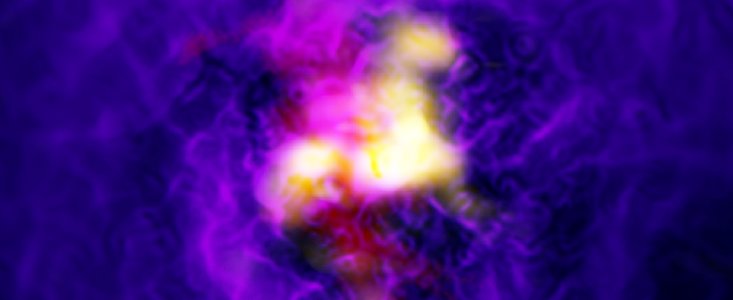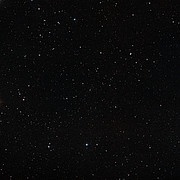Comunicato Stampa
ALMA e MUSE scoprono una fontana galattica
06 Novembre 2018
Le osservazioni di ALMA e i dati dello spettrografo MUSE installato sul VLT dell'ESO hanno rivelato una colossale sorgente di gas molecolare alimentata da un buco nero nella galassia più brillante dell'ammasso Abell 2597 - il ciclo galattico completo di afflusso e deflusso che alimenta questa vasta fontana cosmica non era mai stato osservato prima d'ora nello stesso sistema.
A solo un miliardo di anni luce di distanza, nel vicino ammasso di galassie noto come Abell 2597, giace una gigantesca fontana galattica. Un massiccio buco nero nel cuore di una galassia lontana è stato osservato mentre lancia nello spazio un ampio getto di gas molecolare freddo, che in seguito ricade sul buco nero come un diluvio intergalattico. L'afflusso e il deflusso di una fontana cosmica così vasta non erano mai stati osservati insieme; hanno origine nella zona più interna, di circa 100.000 anni luce, della galassia più luminosa dell'ammasso Abell 2597.
"Questo è probabilmente il primo sistema in cui troviamo una chiara evidenza sia dell'afflusso di gas molecolare freddo verso il buco nero e del deflusso o sollevamento operato dai getti lanciatl dal buco nero", spiega Grant Tremblay dell'Harvard-Smithsonian Center for Astrophysics, ex-Fellow dell'ESO, che ha guidato questo studio. "Il buco nero supermassiccio al centro di questa gigantesca galassia si comporta come una pompa meccanica in una fontana".
Tremblay e il suo team hanno usato ALMA per tracciare la posizione e il movimento delle molecole di monossido di carbonio all'interno della nebulosa. Queste molecole fredde, con temperature fino a meno 250-260 °C, sono state osservate mentre cadono all'interno verso il buco nero. L'equipe ha anche utilizzato i dati dello strumento MUSE sul VLT (Very Large Telescope) dell'ESO per tracciare il gas più caldo, che viene lanciato fuori dal buco nero sotto forma di getti.
"L'aspetto unico qui è l'analisi molto dettagliata della sorgente che abbiamo realizzato utilizzando insieme i dati di ALMA e di MUSE", ha aggiunto Tremblay. "Le due strutture offrono una combinazione di strumenti incredibilmente potente."
Insieme, queste due serie di dati ci danno un quadro completo del processo; il gas freddo cade verso il buco nero, accendendo il buco nero e provocando il lancio nel vuoto di getti di plasma incandescente ad alta velocità. Questi getti quindi fuoriescono dal buco nero come una spettacolare fontana galattica. Senza speranza di sfuggire alle grinfie gravitazionali della galassia, il plasma si raffredda, rallenta e alla fine ricade di nuovo sul buco nero, e il ciclo ricomincia.
Questa osservazione senza precedenti potrebbe far luce sul ciclo di vita delle galassie. Il team ipotizza che questo processo potrebbe essere non solo comune, ma anche essenziale per comprendere la formazione delle galassie. Mentre l'afflusso e il deflusso del gas molecolare freddo sono stati precedentemente rilevati, questa è la prima volta che entrambi sono stati rilevati all'interno di uno stesso sistema e quindi la prima prova che i due eventi fanno parte dello stesso vasto processo.
Abell 2597 si trova nella costellazione dell'Acquario, il nome deriva dalla sua inclusione nel catalogo di Abell di ammassi di galassie ricchi, cioè con un elevato numero di galassie. Il catalogo include anche ammassi come Fornax, Hercules cluster e l'ammasso di Pandora.
Ulteriori Informazioni
Questo lavoro è stato presentato nell'articolo intitolato “A Galaxy-Scale Fountain of Cold Molecular Gas Pumped by a Black Hole”, pubblicato dalla rivista The Astrophysical Journal.
L'equipe è composta da G. R. Tremblay (Harvard-Smithsonian Center for Astrophysics, Cambridge, USA; Yale Center for Astronomy and Astrophysics, Yale University, New Haven, USA), F. Combes (LERMA, Observatoire de Paris, Sorbonne University, Paris, Francia), J. B. R. Oonk (ASTRON, Dwingeloo, Paesi Bassi; Leiden Observatory, Paesi Bassi), H. R. Russell (Institute of Astronomy, Cambridge University, Regno Unito), M. A. McDonald (Kavli Institute for Astrophysics and Space Research, Massachusetts Institute of Technology, Cambridge, USA), M. Gaspari (Department of Astrophysical Sciences, Princeton University, USA), B. Husemann (Max-Planck-Institut für Astronomie, Heidelberg, Germany), P. E. J. Nulsen (Harvard-Smithsonian Center for Astrophysics, Cambridge, USA; ICRAR, University of Western Australia, Crawley, Australia), B. R. McNamara (Physics & Astronomy Department, Waterloo University, Canada), S. L. Hamer (CRAL, Observatoire de Lyon, Université Lyon, Francia), C. P. O’Dea (Department of Physics & Astronomy, University of Manitoba, Winnipeg, Canada; School of Physics & Astronomy, Rochester Institute of Technology, USA), S. A. Baum (School of Physics & Astronomy, Rochester Institute of Technology, USA; Faculty of Science, University of Manitoba, Winnipeg, Canada), T. A. Davis (School of Physics & Astronomy, Cardiff University, Regno Unito), M. Donahue (Physics and Astronomy Department, Michigan State University, East Lansing, USA), G. M. Voit (Physics and Astronomy Department, Michigan State University, East Lansing, USA), A. C. Edge (Department of Physics, Durham University, Regno Unito), E. L. Blanton (Astronomy Department and Institute for Astrophysical Research, Boston University, USA), M. N. Bremer (H. W. Wills Physics Laboratory, University of Bristol, Regno Unito), E. Bulbul (Harvard-Smithsonian Center for Astrophysics, Cambridge, USA), T. E. Clarke (Naval Research Laboratory Remote Sensing Division, Washington, DC, USA), L. P. David (Harvard-Smithsonian Center for Astrophysics, Cambridge, USA), L. O. V. Edwards (Physics Department, California Polytechnic State University, San Luis Obispo, USA), D. Eggerman (Yale Center for Astronomy and Astrophysics, Yale University, New Haven, USA), A. C. Fabian (Institute of Astronomy, Cambridge University, Regno Unito), W. Forman (Harvard-Smithsonian Center for Astrophysics, Cambridge, USA), C. Jones (Harvard-Smithsonian Center for Astrophysics, Cambridge, USA), N. Kerman (Yale Center for Astronomy and Astrophysics, Yale University, New Haven, USA), R. P. Kraft (Harvard-Smithsonian Center for Astrophysics, Cambridge, USA), Y. Li (Center for Computational Astrophysics, Flatiron Institute, New York, USA; Department of Astronomy, University of Michigan, Ann Arbor, USA), M. Powell (Yale Center for Astronomy and Astrophysics, Yale University, New Haven, USA), S. W. Randall (Harvard-Smithsonian Center for Astrophysics, Cambridge, USA), P. Salomé (LERMA, Observatoire de Paris, Sorbonne University, Paris, Francia), A. Simionescu (Institute of Space and Astronautical Science [ISAS], Kanagawa, Giappone), Y. Su (Harvard-Smithsonian Center for Astrophysics, Cambridge, USA), M. Sun (Department of Physics and Astronomy, University of Alabama in Huntsville, USA), C. M. Urry (Yale Center for Astronomy and Astrophysics, Yale University, New Haven, USA), A. N. Vantyghem (Physics & Astronomy Department, Waterloo University, Canada), B. J. Wilkes (Harvard-Smithsonian Center for Astrophysics, Cambridge, USA) e J. A. ZuHone (Harvard-Smithsonian Center for Astrophysics, Cambridge, USA).
L'ESO (European Southern Observatory, o Osservatorio Australe Europeo) è la principale organizzazione intergovernativa di Astronomia in Europa e di gran lunga l'osservatorio astronomico più produttivo al mondo. È sostenuto da 16 paesi: Austria, Belgio, Danimarca, Finlandia, Francia, Germania, Irlanda, Italia, Paesi Bassi, Polonia, Portogallo, Regno Unito, Repubblica Ceca, Spagna, Svezia, e Svizzera, oltre al paese che ospita l'ESO, il Cile e l'Australia come partner strategico. L'ESO svolge un ambizioso programma che si concentra sulla progettazione, costruzione e gestione di potenti strumenti astronomici da terra che consentano agli astronomi di realizzare importanti scoperte scientifiche. L'ESO ha anche un ruolo di punta nel promuovere e organizzare la cooperazione nella ricerca astronomica. L'ESO gestisce tre siti osservativi unici al mondo in Cile: La Silla, Paranal e Chajnantor. Sul Paranal, l'ESO gestisce il Very Large Telescope, osservatorio astronomico d'avanguardia nella banda visibile e due telescopi per survey. VISTA, il più grande telescopio per survey al mondo, lavora nella banda infrarossa mentre il VST (VLT Survey Telescope) è il più grande telescopio progettato appositamente per produrre survey del cielo in luce visibile. L'ESO è il partner principale di APEX e di ALMA, il più grande progetto astronomico esistente, sulla piana di Chajnantor. E sul Cerro Armazones, vicino al Paranal, l'ESO sta costruendo l'Extremely Large Telescope o ELT (significa Telescopio Estremamente Grande), un telescopio da 39 metri che diventerà "il più grande occhio del mondo rivolto al cielo".
La traduzione dall'inglese dei comunicati stampa dell'ESO è un servizio dalla Rete di Divulgazione Scientifica dell'ESO (ESON: ESO Science Outreach Network) composta da ricercatori e divulgatori scientifici da tutti gli Stati Membri dell'ESO e altri paesi. Il nodo italiano della rete ESON è gestito da Anna Wolter.
Links
Contatti
Anna Wolter
INAF - Osservatorio Astronomico di Brera
Milano, ITALY
Tel.: +39-02-72320321
E-mail: anna.wolter@inaf.it
Grant Tremblay
Harvard-Smithsonian Center for Astrophysics
Cambridge, USA
Tel.: +1 207 504 4862
E-mail: grant.tremblay@cfa.harvard.edu
Francoise Combes
LERMA, Paris Observatory
Paris, France
E-mail: francoise.combes@obspm.fr
Calum Turner
ESO Public Information Officer
Garching bei München, Germany
Tel.: +49 89 3200 6670
E-mail: pio@eso.org
Sul Comunicato Stampa
| Comunicato Stampa N": | eso1836it |
| Nome: | Abell 2597 |
| Tipo: | Local Universe : Galaxy : Grouping : Cluster |
| Facility: | Atacama Large Millimeter/submillimeter Array, Very Large Telescope |
| Science data: | 2018ApJ...865...13T |





